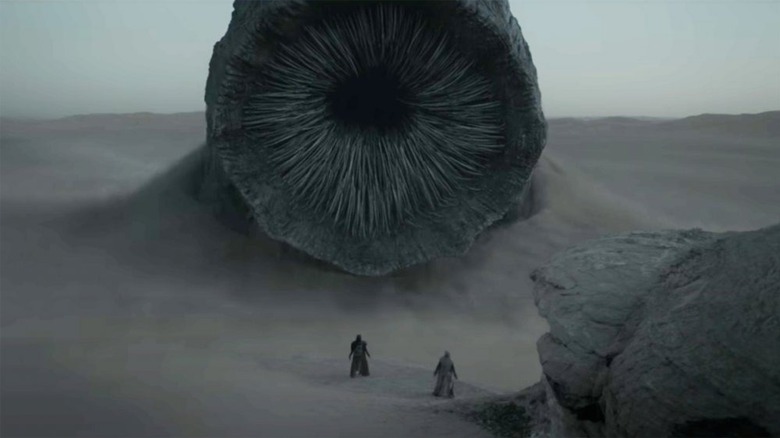Neil deGrasse Tyson Pointed Out Dune's Big Sandworm Problem - And We Can't Unsee It
Talk show host and creator of the "Lord of the Rings" rap Stephen Colbert is a noted fantasy fan. Neil deGrasse Tyson has harnessed his astrophysicist skills to reveal the location of Barbieland in "Barbie." When the latter visited "Late Night with Stephen Colbert," it's no surprise that the discussion soon turned to Denis Villeneuve's excellent "Dune: Part Two," and the pair soon started a good-natured debate on whether the sci-fi juggernaut is a perfect movie. During the conversation, Tyson made a fascinating point about the movie's gigantic sandworms' function.
"The Fremen, Indigenous sand people, one of the rites of passage is they have to ride the back of the worm. Okay. But it's a worm just going straight fast," Tyson said. "Have you ever seen a snake chase you as a straight snake? No! They've got to curl and they push off the curl. That's what the curling is."
Tyson's observation easily changes how viewers look at the sandworms' locomotion. Sure, the giant creatures' comparatively straightforward advancement is terrifying, but imagine how creepy they would be if they squirmed and curled like snakes. How much more difficult would that make the Fremen's sandworm riding challenge?
Sandworms are a combination of realistic and impossible
Surprisingly, the film's sandworms are "close enough to something we understand on Earth," according to biologist Michael Werner (via Popular Science). From the way they sense rhythmic patterns to the filtration systems in their mouths and their narcotic-like secretions, sandworms have several similarities to various reptiles. (Still, their size would be untenable!)
Sure, some of the sandworms' most curious aspects have stranger explanations. How do creatures this huge feed themselves? Well, they gulps of sand and any potential nutrients within their wake. As for water, it's outright fatal to them, so it's clear that Earth could never be their home. But let's not forget that the genre is called science fiction for a reason. "Dune – Part Two" utilizes its seemingly predatory sandworm scenes amazingly. Even though Neil deGrasse Tyson pointed out inaccuracies about how they move, the creatures here are still cool enough to justify a little suspension of disbelief. Besides, the real meaning of sandworms in "Dune" is so complex that it's perfectly understandable Frank Herbert chose to risk biological accuracy for a thrilling twist.

